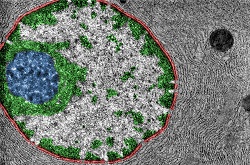Novel methods lift the veil on chromatin’s role in gene expression
For Prof Bas van Steensel, Chromatin Genomics Group Leader at the Netherlands Cancer Institute, the CHROMATINPRINCIPLES project was all about seeing the bigger picture. Whilst the scientific community already knows much about interactions between chromatin proteins, how they are organised as a network remains a mystery. ‘Chromatin is very complex, because it consists of hundreds of proteins. How these proteins work together to form distinct types of chromatin is poorly understood. Moreover, we need to understand how different chromatin types control gene expression,’ says Prof van Steensel. In other words, the team had to develop better tools to study chromatin and gene regulation. Their previous studies on drosophila had already shed some light on the principle types of chromatins. One of these, a novel repressive type of chromatin that covers nearly half of the fly genome called BLACK chromatin, was of particular interest. Its embedded genes are inactive – suggesting that this chromatin type helps to repress gene activity – and it tends to be positioned at the edge of the nucleus (the nuclear lamina), pointing to a role in the spatial organization of the genome. By focusing on BLACK chromatin, the team hoped to gain insight into the basic mechanisms that drive the partitioning of the genome into distinct chromatin types. Technical problems in Drosophila cells, however, forced the team to shift its attention towards a closely-related type of chromatin in mammalian cells known as lamina associated domains (LADs). ‘Like drosophila BLACK chromatin, mammalian LADs are thought to repress gene activity, and they are located at the edge of the nucleus. We developed exciting new methods to visualise and track LADs in living cells, and to map the contacts of LADs genome-wide in single cells,’ says Prof van Steensel. There were three main methods developed under the project: TRIP, for integrating a reporter gene that can sense local chromatin effects across the genome; SuRE, which allowed the team to generate a catalogue of all regions in the human genome that can drive gene expression in the absence of a chromatin context; and TIDE, a web-based tool that can help interested researchers to test genome editing by means of the CRISPR technology. The results were outstanding: ‘We found strong evidence that LADs repress gene activity,’ Prof van Steensel says. ‘Our different approaches also revealed that the LAD contacts with the lamina are highly dynamic, and that they are subjected to extensive reshuffling each time the cell divides. There is, however, a subset of LADs that are very stably anchored to the lamina in almost every single cell. They may help organise chromosomes inside the nucleus. Finally, we identified one chromatin modification in LADs that promotes lamina interactions.’ Now that the project is completed, the team hope that all the project’s insights will contribute to scientific understanding of gene regulation, and that the new methods they developed will be adopted and further modified by other labs. In the meantime, Prof van Steensel has been awarded another ERC Advanced Grant. His new goal is to further explore the interactions of the genome with the nuclear lamina, as well as develop additional tools to manipulate the genome at large scale, so as to find out how DNA sequence drives interactions with the nuclear lamina.
Keywords
CHROMATINPRINCIPLES, chromatin, black chromatin, nucleus, DNA, proteins, gene expression, LADs, CRISPR, lamina associated domains



